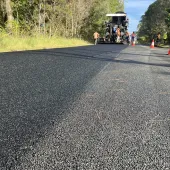Stripping At The Interface

The close relationship between bitumen and aggregate sometimes needs help
It is well known that adhesion at the interface between bitumen and aggregate is one of the principal functional properties to guarantee the durability of asphalt mixes. But the bond can be reduced and the cohesion within asphalt lost through the presence of water at the bitumen/stone interface. This phenomenon is known as ‘stripping’.
Visual damage such as early ravelling of a top layer or surface treatment can be a consequence of stripping. When water gets to the base or binder layer, stripping can result in overstressing of the underlying pavement layers and, ultimately, create excessive permanent deformation or translate into earlier than expected fatigue failure.
Combating the phenomenon becomes ever more important as open asphalt types such as ‘ZOAB’ (porous asphalt) and other thin, noise-reducing top layers with an open texture grow in popularity. Due to their texture, water has the opportunity to permeate through to and affect the different layers in the pavement construction.
For dense asphalt mixes, besides a good mix design, a sufficient amount of binder and adequate compaction play a major role in the moisture sensitivity of the pavement. The worst-case condition is a dense asphalt mix with 8–12% of air voids where moisture can readily enter the pavement but not easily escape.
Improving compaction to reduce the void content to between 6% and 8% will improve moisture resistance and also reduce permeability (the amount of interconnected voids) in the pavement.
The research and development department at Nynas is continuously involved in research into the performance of bitumen and its application in asphalt mixes. As well as their own investigations, Nynas have performed a literature study on relevant research projects and papers presented at conferences in recent years. From this, it can be seen that researchers around the world have arrived at interesting conclusions in trying to understand and explain the stripping phenomenon.
Research into the stripping effect can be divided into three levels of investigation: micro, meso and macro. On a micro scale, H. Plancher et al1 looked for components in bitumen which display a particular ability to adhere to specific components in the aggregate structure. The polarity of these components can explain a strong polar bond.
A polar bond is where components with opposite electrical loading/charge attract each other. Normally this type of bond is very strong. However, the more polar components seem to be soluble and vulnerable to the ‘polar solvent’ action of water, which has the effect of removing polar bond.
On a meso scale, Ingo Nösler2 conducted research into the objective quantification of the remaining percentage of bitumen-coated aggregates after the mix was exposed to miscellaneous humid conditions. Here the emphasis was on avoiding visual determination in favour of analysis employing a photometric method.
Furthermore, he quantified the objective adhesion by measuring the loss of the E-Modulus of compacted asphalt samples by using a Nottingham Asphalt Tester (NAT). With this method the same asphalt samples were tested before and after the water treatment.
On a macro scale, Dale A. Rand et al3 tried to quantify the effects on functional properties by performing wheel-tracking (or rutting tests) under water.
In some of these projects, several aggregate types were investigated and can be categorized in mineral families such as quartzite, porphyry, limestone, granite and others. Bitumens of different origins were also used, ranging from waxy types to paraffinic and naphthenic types (fig. 1).
It is known from experience and through experiments that some aggregates possess characteristics that allow very good adhesion. Other stone types exist that display bad adhesion. Similarly with bitumen, different results can be obtained.
In figure 1 the adhesion of three types of bitumen to different stone types is displayed. From these results it is very obvious that the adhesion of bitumen to stone is mainly determined by the properties of the aggregate. The influence of the bitumen type is almost negligible. Only with stone types displaying bad coating or adhesion characteristics can some effect of the bitumen be observed. This means that, with well selected bitumen, the adhesion of the aggregate type can be optimized.
It is also interesting to note that the quartzite and granite families can display both better and worse adhesion qualities. For instance, the porphyry in figure 1 is not comparable with the good-quality porphyry of, for example, Quenast Quarry in Belgium.
A large number of research projects4 have shown that lime treatment, for example the addition of hydrated lime (Ca(OH)2), has a high potential to compensate for bad adhesion, independent of the stone or bitumen type. Also, dopes, liquid anti-stripping agents and other additives can also achieve an amelioration. However, such additives act more selectively and do not have a consistent affect on all aggregates.
Conclusions
Asphalt can have a durable character thanks to the good adhesion properties of bitumen to aggregate. However, this adhesion can be negatively influenced by water (stripping), a phenomenon that has been the subject of international research for many years.
The research and development department at Nynas has performed a literature study on recent scientific investigations and findings. From this study it is clear that the origin and properties of the mineral aggregate have a dominant effect compared to the origin of the bitumen5.
Usually, the reduced resistance against stripping of certain types of aggregate can be improved by adding hydrated lime (or filler containing hydrated lime) to the asphalt mix. The use of additives in the bitumen can also improve the adhesion, but in general these work more selectively and depend on the aggregate/bitumen combination. As additives do not have a consistent affect on all aggregates, trial and selection is recommended.
References
- PLANCHER, H., DORRENCE, S. M., and J. C. PETERSEN: ‘Identification of chemical types in asphalts strongly adsorbed at the asphalt aggregate interface and their relative displacement by water’, AAPT, 1977, vol. 46, p 151.
- NÖSLER, I.: ‘A contribution to the objective and quantitative measurement of the adhesion between aggregates and bitumen’, Thesis work, 1999, University of Wuppertal, Institute of Road Construction.
- RAND, D. A.: ‘HMA moisture sensitivity, past, present and future, TxDOT experiences’, paper presented at the Moisture Damage Symposium, 39th annual meeting of the Petersen Asphalt Research Conference, Wyoming, July 2002.
- LITTLE, D. N., and J. A. EPPS: ‘The benefits of hydrated lime in hot-mix asphalt’, prepared for Chemical Lime Corp., Texas Transportation Institute, 2001.
- BLAZEK, J., SEBOR, G., and D. MAXA: ‘Effect of aggregate composition on asphalt–aggregate adhesion’, Petroleum and Coal, 2000, vol. 42, no. 1, pp 46–51.
This article first appeared in Performance, the Nynas Bitumen magazine, and is reproduced here by kind permission of Nynas Bitumen (www.nynas.com)








